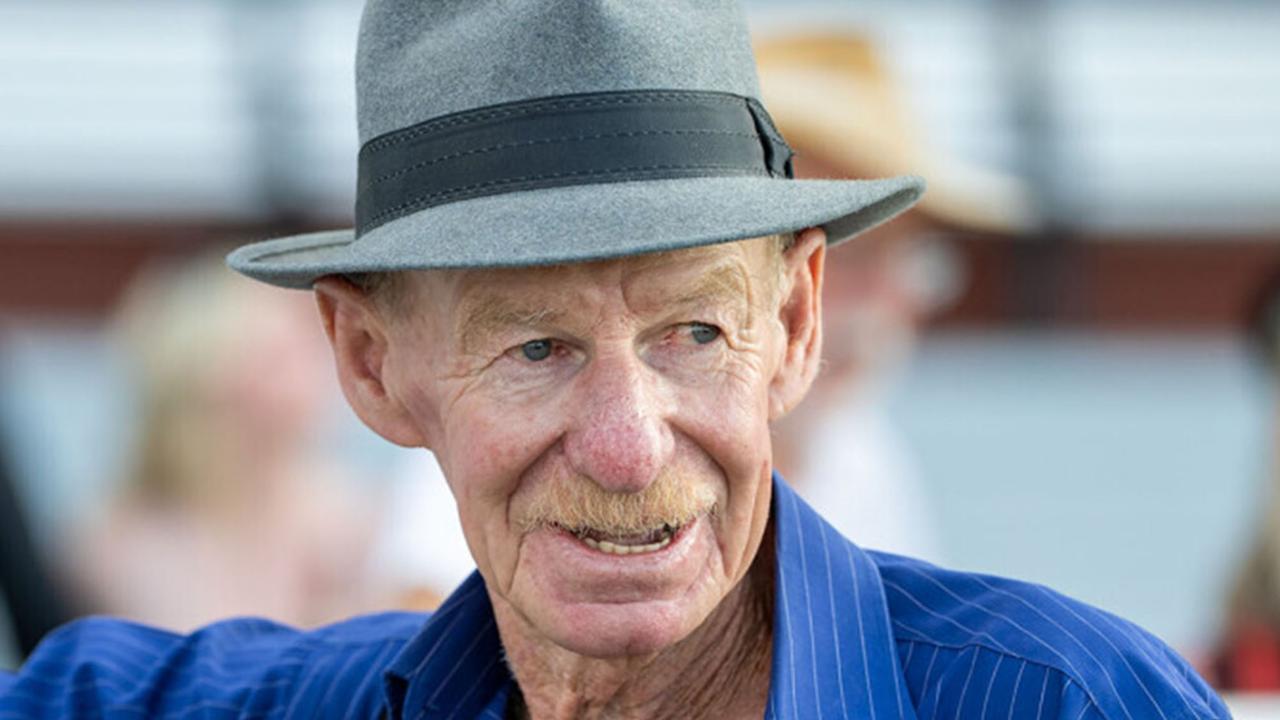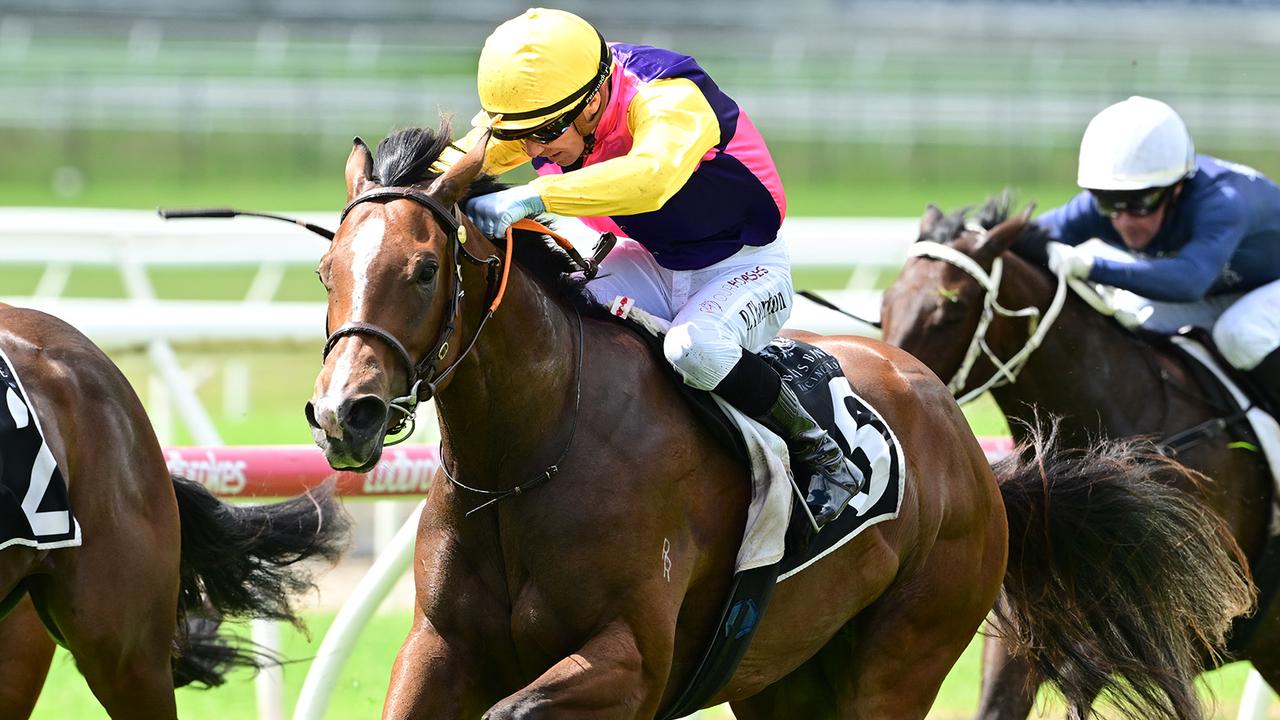Girl power: Why mares are dominating Australian racing
Since 2000, mares have won 16 of the 25 Australian Horse of the Year titles … and that will continue this year when Via Sistina takes her place among an honour roll that features Winx, Black Caviar, Makybe Diva and Sunline.
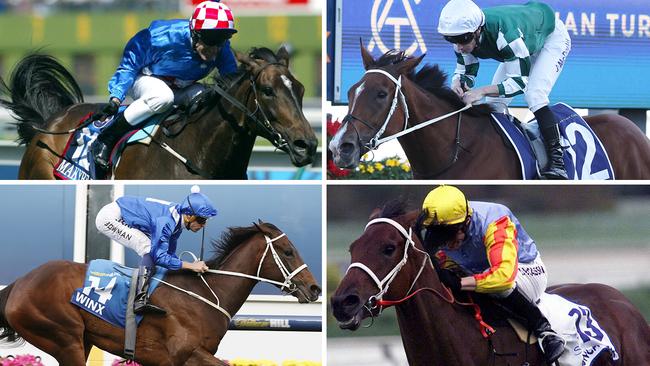
Racing
Don't miss out on the headlines from Racing. Followed categories will be added to My News.
Champion Via Sistina’s majestic Queen Elizabeth Stakes win is a continuation of the “female phenomenon” dominating Australian racing.
Since 2000, mares have won 16 of the 25 Horse of the Year titles, and that record is about to be enhanced with Via Sistina certain to win the award this season.
It all began when Sunline began the sequence with her Horse of the Year three-peat in 2000-01-02 before Makybe Diva went back-to-back in 2005 and 2006 then Miss Andretti won the title in 2007.
Typhoon Tracy was voted Horse of the Year in 2010 before the legendary Black Caviar’s hat-trick of titles in 2011-12-13 during her unbeaten 25-start career.
The mighty Winx then dominated Australian racing when she won 33 consecutive races and collected a record four Horse of the Year titles in succession from 2016 to 2019.
Verry Elleegant (2021) and Pride Of Jenni (2024) are mares who have also claimed Australian racing’s ultimate accolade in recent years.
• PUNT LIKE A PRO: Become a Racenet iQ member and get expert tips – with fully transparent return on investment statistics – from Racenet’s team of professional punters at our Pro Tips section. SUBSCRIBE NOW!
Via Sistina’s name will be added to that list later this year to increase the ratio of mares claiming the Horse of the Year title at 65 per cent this century. Her win in the Queen Elizabeth Stakes last Saturday was her seventh at Group 1 level of 2024-25, equalling Winx’s record for most majors in a season set in 2018-19.
But in the 25 years leading up to 2000, mares won Horse of the Year only seven times (28 per cent) including only one winner from 1987 to 2000 and that was Let’s Elope in 1992.
So, why are mares so successful in the modern era?
🆠Via Sistina v Winx ðŸ†
— Racing.com (@Racing) October 26, 2024
Their two Cox Plate track records side-by-side is incredible viewing 🙌 pic.twitter.com/1xvBXt39xY
• Kiwi raider seeks more Group 1 glory in All Aged
The reasons are many and varied. On the matter of pure economics, many of the top colts are simply too valuable as stallion prospects to risk racing beyond their three-year-old seasons. Instead, they are sent to stud where they can stand at a lucrative fee and serve more than 150 broodmares a season.
For race mares like Via Sistina and Fangirl, obviously they can only produce one foal a season but even then there are no guarantees.
But these elite mares can continue to compete at six, seven and eight years of age, even older if they are maintaining form and fitness, and earn plenty of prizemoney on the racetrack.
Last Saturday at Randwick, Via Sistina and Fangirl (Queen of the Turf Stakes) both took their career earnings past $10 million with their Group 1 wins.
The champ Via Sistina claims the G1 Queen Elizabeth Stakes with ease, equalling Winx's record of 7 Group 1's in a season! 🤩 What a mare!@cwallerracing | @mcacajamez | @YulongInvest | @aus_turf_club | @WorldPoolpic.twitter.com/oMBNGpAyv8
— SKY Racing (@SkyRacingAU) April 12, 2025
• Blackbookers: Early feature race tips in three states
The mares are again lining up in numbers again to compete for Sydney’s final Group 1 of the season at Royal Randwick on Saturday with the likes of Magic Time, Joliestar, Sunshine In Paris, Belclare, Benedetta, Kimochi amd Grail Seekeramong the main chances in the Group 1 $1.5 million All Aged Stakes (1400m).
Trainer Grahame Begg’s top mare Magic Time can achieve a unique feat if she successfully defends her title in the All Aged Stakes.
First run in 1865, the All Aged Stakes is one of the nation’s oldest feature races and boasts an honour roll that reads like a “who’s who of Australian racing.’’
But in the race’s 160-year history, no mare has ever gone back-to-back in the weight-for-age sprint.
Just magic! 🪄
— SKY Racing (@SkyRacingAU) April 20, 2024
Magic Time wins the G1 All Aged Stakes!@aus_turf_club@Grahame_Beggpic.twitter.com/iN79h3bCih
• ‘Done enormous’: Unbeaten filly can add spice to Champagne
The great mare Sunline is a dual All Aged Stakes winner in 2000 and again in 2002 while the only other mare to win the race twice is Gladsome in 1904 and 1906.
Begg said the modern trend for mares to have extended race careers could be very lucrative.
“It is pretty evident mares that are getting to five, six and seven years of age and are still racing are only just getting to their top as racehorses,’’ Begg said.
“Some of the mares my father, Neville, trained over the years retired too early like November Rain.
“She won three Oaks but was retired as a four-year-old because at the time, that was the thought process.’’
On the eve of Magic Time’s bid for history in the All Aged Stakes, it is worth revisiting Hall of Fame trainer Neville Begg’s record with fillies and mares as it makes for compelling reading.
Before Begg left for Hong Kong in 1990, he had trained 34 Australian Group 1 winners which included no fewer than 27 majors with fillies or mares.
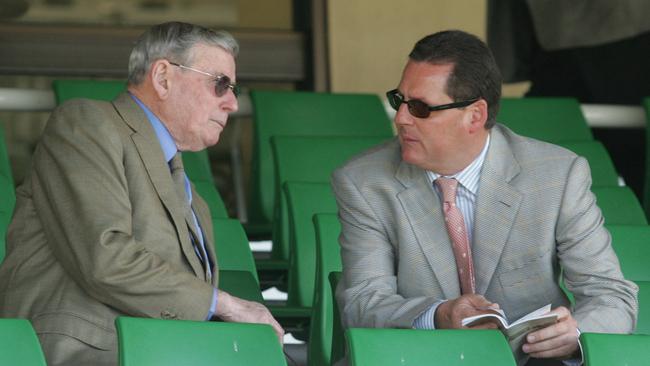
• Thousand Guineas moves back to October in Spring reshuffle
Begg did train many top class “males” including AJC Australian Derby winner Divide And Rule, the outstanding Dalmacia and Veloso, and a sprinter he bred and trained, Hit It Benny.
But it was Begg’s extraordinary record with fillies and mares like Emancipation, November Rain, Kapalaran, Dark Eclipse, Sufficient, Heat Of The Moment and Palace Revolt, that prompted this writer to seek his opinion on the “female phenomenon” in Australian racing.
“I trained for a lot of owner-breeders who liked to get some black type with their fillies then breed with them,’’ Begg explained.
“Back in my day, it was the colts that raced on as older horses but nowadays they tend not to race the good colts for very long anymore.’’
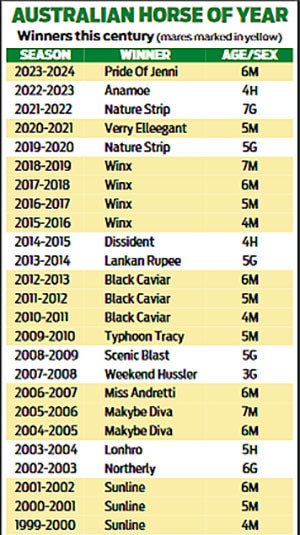
Begg is 94 years young and although the passing of time might have slowed his mobility, his powers of recall remain as fast and accurate as ever.
When I contacted Begg this week to talk about the changing nature of Australian racing, the conversation became an engrossing walk down racing’s memory lane that began with the Todman-Tulloch era of the late 1950s.
Begg was working as stable foreman for Maurice McCarten when the trainer’s juvenile sensation Todman won the inaugural 1957 Golden Slipper by eight lengths.
Then Todman and Tulloch clashed in successive starts in the AJC Sires Produce Stakes and Champagne Stakes with the honours shared.
• Mitch Cohen’s Blackbook: Five to follow from Randwick on Saturday
“Tulloch beat Todman in the Sires then they both backed up in the Champagne which was only six furlongs (1200m) in those days and Todman was too fast,’’ Begg said.
The two great champions never raced against each other again but remarkably injury and illness robbed both of their entire four-year-old seasons.
After winning the Hobartville Stakes and Canterbury Guineas as a spring three-year-old, Todman then broke down with a serious leg injury and did not race again until the autumn of his five-year-old season.
“Todman had nearly two years off with a crack in his hind leg,’’ Begg said.
“When he finally came back he broke the Canterbury track record first-up, then won the Lightning Stakes and the Futurity Stakes before Mr (Stanley) Wootton retired the horse to stud.’’

• All Aged to set Antino on his way to Pride Of Jenni showdown
Tulloch suffered from a stomach illness at the end of his three-year-old season and, like Todman, didn’t make a comeback to racing until he was an autumn five-year-old when he scored a famous first-up win over Lord in the Queen’s Plate. He raced for another season before being retired to stud.
But this goes back to Begg’s earlier point that the breeding industry was very different in the Todman-Tulloch era when entires had longer long race careers.
“The good stallions would serve about 45 mares a season in those days,’’ Begg said. “But they serve 145 mares now.’’
Since 2000, the only entire good enough to earn Horse of the Year that raced as a five-year-old was champion Lonhro in 2004. Anamoe was a four-year-old when he won Horse of the Year before retiring to stud two years ago.
Begg was directly associated with two champion mares that won the All Aged Stakes – Wenona Girl in 1964 and Emancipation 20 years later.
Wenona Girl, a flashy chestnut filly with a flaxen mane from the McCarten stable, began her career winning the 1959 Gimcrack Stakes.
By the time Wenona Girl retired five years later, she had won 27 races of which 15 would be recognised as Group 1 races today. She ran top two in 46 of her 68 starts.
• Fangirl, J-Mac stage fantastic finish in Queen Of The Turf
“Wenona Girl was an outstanding mare,’’ Begg said. “She was like a kid’s pony because she was such a quiet ride.
“But one morning on the track, Neville Sellwood rode her and gave her one behind and she just took off. She never looked back after that and went on to be a champion.’’
Begg revealed Wenona Girl had one concerning trait that she was never able to overcome.
“She was a box-walker from the moment she came into the stable,’’ he said. “She was the worst I have ever seen and would walk around her box like a tiger.
“We had to keep her tied up for about an hour after trackwork until she settled down again.
“It was nervous energy more than anything and she was the same all her life.’’
Begg said Wenona Girl’s box-walking aside, she was a gentle mare with a “beautiful nature”.
“I used to ride her down to the track in the mornings and she would walk 50 yards then stop and look around,’’ he said.
“Then she would walk another 50 yards or so and stop to look again. But the minute she put her foot on the track, away she went.’’
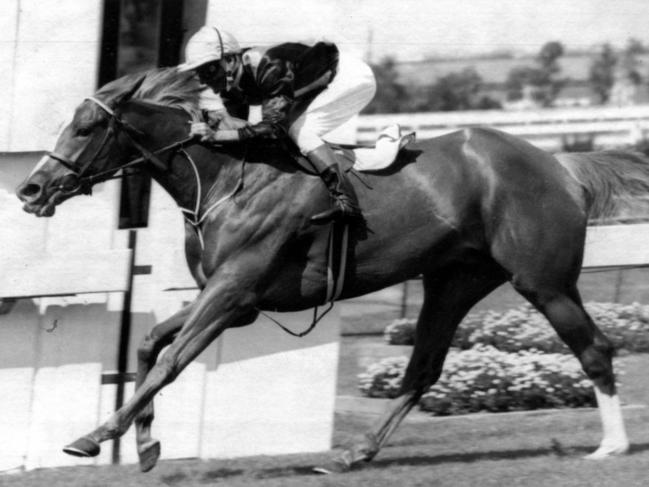
• Via Sistina joins Winx with crowning glory in Queen Elizabeth
When Wenona Girl was retired from racing, she was mated with McCarten’s former super sprinter Todman and they produced the appropriately named Special Girl, who Begg trained.
“Special Girl was a very good two-year-old, she had brilliant speed,’’ Begg said.
“One day George Moore rode her, she was 20/1 on at Warwick Farm and was cantering to the post but still won by six lengths.
“We had great hopes for her and she went into the (1969) Golden Slipper unbeaten but she ran into Vain that day. He was another story – an out and out champion.’’
Begg prepared Emancipation to win the 1984 All-Aged Stakes, the same season she was voted Horse of the Year.
Emancipation won 19 of her 28 races including six at Group 1 level and Begg maintains the grey mare was the best horse he ever trained.
• Tempted atones for Slipper defeat with gutsy Percy Sykes win
“I don’t care about any of the good mares that have come after Emancipation because she would have more than held her own against them up to a mile,’’ he said.
“She raced against the best at weight-for-age and in handicaps, and was successful in all over them. She had such a great turn of foot, she could sit anywhere and outsprint them.’’
Some of Emancipation’s greatest wins came as a three-year-old filly when she ran down the mighty Manikato to win the George Ryder Stakes then at her next start she won the Doncaster Mile despite having to carry 1.5kg over weight-for-age.
In the autumn of 1984, Emancipation was involved in three memorable clashes with champion colt Sir Dapper with the mare winning the decider in the All Aged Stakes.
“A lot of people thought when Emancipation beat Sir Dapper at Rosehill the colt was unlucky but when they met for a third time in the All Aged Stakes, she beat him again,’’ Begg said.
Emancipation was a temperamental mare and could be difficult to manage and train.
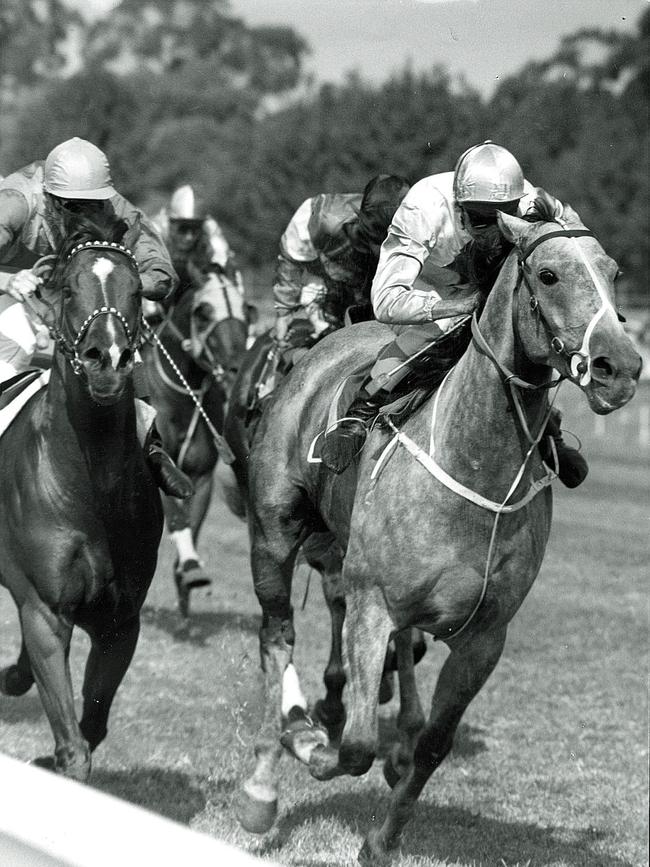
• Treasurethe Moment snatches ‘incredible’ Oaks victory from defeat
“Grahame used to look after Emancipation and he got on well with her,’’ Begg said.
“But she was always in a hurry to do everything and she had a mind of her own.
“I remember sometimes in her box she would kick the hell out of it.’’
Begg said his son has also done a “great job” with Magic Time and hopes they are rewarded with a historic second successive All Aged Stakes.
“Magic Time has been a very good mare for Grahame and his stable,’’ Begg said.
“Since she was sold, the new owners (Yulong) were good enough to leave her with him and she has continues to race very well. She should be hard to beat on Saturday.’’
Originally published as Girl power: Why mares are dominating Australian racing

